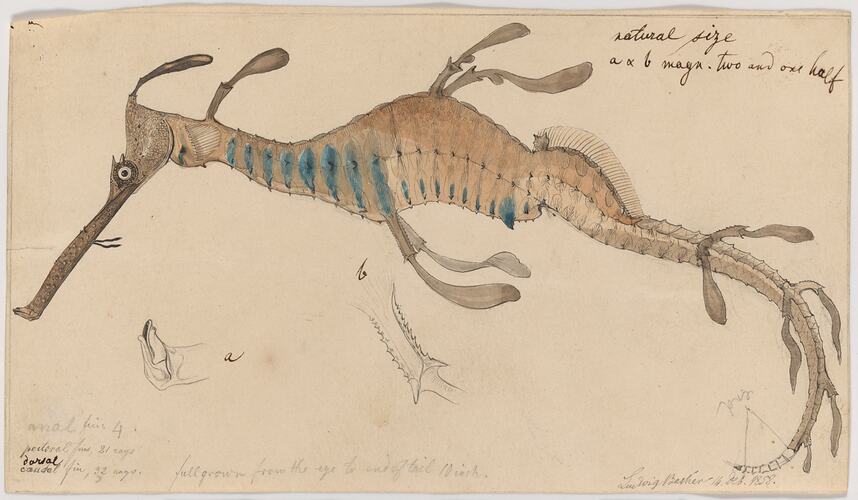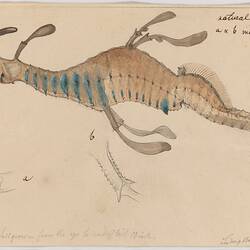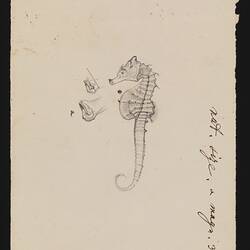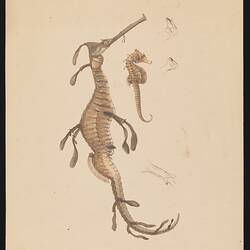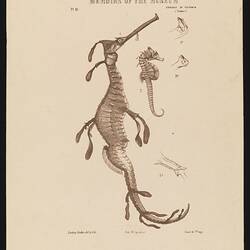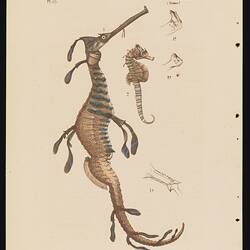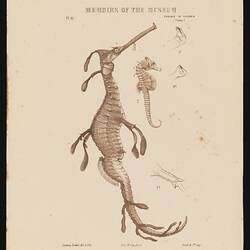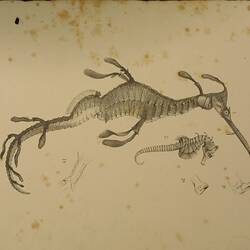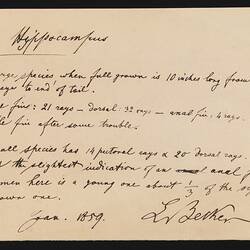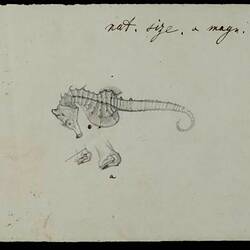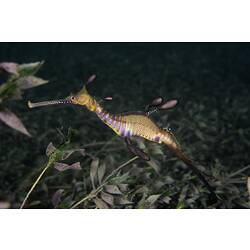Summary
Ludwig Becker's 1858 watercolour is the first known illustration of a Common Seadragon from Victorian waters. It was commissioned by Sir Frederick McCoy, Director of the National Museum of Victoria, as part of his zoological research. The fish may have been dead when the artist captured its likeness with his watercolours, for while Becker's spidery lines capture its extraordinary form, the colour is rather more drab than in life. In his accompanying description, McCoy speculated that an Aboriginal drawing he had seen was 'manifestly inspired' by the seadragon. Unfortunately that work has never come to light. It is pleasantly ironic that this animal, which McCoy described as a 'most singular-looking fish', is now the official marine emblem of Victoria.
This illustration forms part of the much larger Prodromus Collection. Many of the oriignal illustrations in the collection informed the production of the two volume work The Prodromus of the Zoology of Victoria which was Museum Victoria's first major publication from 1878. The Prodromus project followed a popular formula of the time, seeking to identify and classify the natural wonders of the 'new world'. Such publications reached a peak in popularity with the work of John Gould in England and the earlier work of James Audobon in America. In Australia, many professional and amateur publications, including Aldine's systematic studies of the colonies, and Louise Anne Meredith's Bush Friends From Tasmania, contributed to the genre.
The publication of the Prodromus was an enormous undertaking, utilising the work of numerous artists, collectors, lithographers and publishers, over an extended period of time. McCoy died without completing his systematic study, but even at the time few believed that 'any of us will live to witness the completion of the work, if the entire Fauna of Victoria is to be illustrated.' Although costly in both financial and professional terms, it was met with critical acclaim and wide popular support. Financial battles were waged and lost by McCoy, but ultimately the Prodromus has stood the test of time and remains one of Museum Victoria's finest publications.
Description of Content
Common Seadragon, Phyllopteryx taeniolatus, by Ludwig Becker. Unnumbered watercolour, pencil and Indian ink illustration on paper, 14 Dec 1858, for Plate 65 in The Prodromus of the Zoology of Victoria by Frederick McCoy.
More Information
-
Collection Names
-
Collecting Areas
-
Artist
-
Medium
Pencil, watercolour and indian ink on paper
-
Plate Number
65
-
State
Illustration
-
Primary Inscriptions
Natural size a & b magn. Two and one half.
-
Secondary Inscriptions
full grown from eye to end of tail 10 inch. / Ludwig Becker / 14th December 1858.
-
Classification
-
Taxon Name
-
Author and date of publication
(Lacepède, 1804)
-
Preferred Common name
Common Seadragon
-
Other Common Names
Weedy Seadragon
-
Kingdom
-
Phylum
-
Subphylum
-
Superclass
-
Class
-
Order
-
Suborder
-
Family
-
Genus
-
Species Name
taeniolatus
-
Category
-
Discipline
-
Type of item
-
Primary support
194 mm (Width), 113 mm (Height)
Irregular
-
Framed
455 mm (Width), 648 mm (Height)
Art of Science, 2 items in single frame: PZD 1003 & PZ 65.1
-
Overall Dimensions
193 cm (Width), 110 cm (Height)
-
Maximum dimensions
193 mm (Width), 110 mm (Height)
Measurement From Conservation. Left and right edges not even
-
Minimum dimensions
193 mm (Width), 107 mm (Height)
Measurement From Conservation. Left and right edges not even
-
References
[Book Series] McCoy, Frederick. 1878-1890. Natural History of Victoria: Prodromus of the Zoology of Victoria or Figures and Descriptions of the Living Species of All Classes of the Victorian Indigenous Animals. 1-2.
[Article] Yen, Alan L., et al. 2001. McCoy's Prodromus of the Zoology of Victoria: an unfinished task. Vic. Nat. 118 (6): 242-255.
